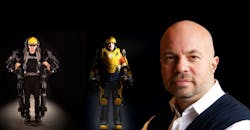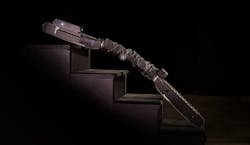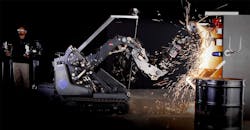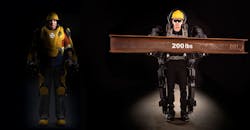Exosuit Maker's Journey from War Machines to Industrial Iron Men (and Women)
The 35-year-old Sarcos Robotics is about to redefine how the toughest industrial jobs are done, although if you’ve heard of the Salt-Lake City-based company, you may only associate it with bleeding edge military projects. Since 2000, Sarcos has been on the front lines of the push to create force-multiplying exoskeletons, suits a person dons to increase strength. DARPA first funded the bioengineering enterprise in 2000 to help soldiers carry heavy loads. Newer, stronger exoskeletons followed suit as a subsidiary of Raytheon, with the XOS-2 drawing comparisons in the press to Iron Man. Next year, the now independent Sarcos will unveil the latest in industrial fashion, the Guardian XO and XO MAX. The battery-powered exoskeletons will allow users to lift 80 lb. and 200 lb. respectively with zero strain on the wearer for up to eight hours. There’s also the Guardian GT, a rideable mech with two powerful arms that can be teleoperated.
To ensure the new power suits can meet the needs of the industry, Sarcos partnered with BMW, CAT, GE, and others to form the Exoskeleton Technical Advisory Group (X-TAG), which will meet quarterly to discuss design and application considerations.
Chairman and CEO Ben Wolff, who came from the private equity world, has led this power play after his management team bought the company in 2015. The former lawyer recently shared with our writer Matt LaWell how this change came about and what it means for workers.
LaWell: How did Sarcos transition from military-industrial complex to complex industrial material?
Wolff: In the earliest days, Sarcos was focused on making prosthetics. So the team became very familiar with biomechanics and how machines can intimately fit and work with the human body. By the early ’90s, Sarcos was in the robotics business translating all of our knowledge about biomechanics and how machines intimately paired with humans into the robotics space.
DARPA was originally interested in concepts that would allow soldiers to have more endurance packing a heavy load. Over time that changed as we developed a greater understanding of what a full-body exoskeleton could do. Then we started looking at how you can build an exoskeleton that is powered, that can not only enhance endurance but also enhance strength. So that now, one human being wearing an exoskeleton could do the work from a lifting perspective of as many as three, four, five humans. And to do it far more safely. There's a huge problem both in the military and also in the commercial sectors with people getting injured on the job, hurting their backs from either the way they lift or from lifting too much.
LaWell: And you decided to solve that commercial sector problem?
Wolff: I had not even contemplated having a career that would focus on robotics until we started looking at acquiring the business back in 2012. I had been in Telecom for most of my entrepreneurial career. I spent six months getting to know the business and the team and the technologies. At the end of 2014, the management team and I had an opportunity to buy the business from Raytheon and we started focusing the business on becoming a product company, specifically bringing the Guardian S [surveillance and inspection tool], the XO, and the GT to market.
In many ways our philosophy is a big departure from the way a lot of robotics companies have evolved. If you look at what robotics companies over the last 15 years have done, they've been very, very focused on having you produce a machine or a product that can solve a specific problem: a machine on an assembly line that can do a specific task better, faster, cheaper than humans can, for example, or a robot that is intended to inspect the inside of an oil pipeline. Those are single-purpose robots. The machine that's good on the factory floor and on an assembly line can't go do other things. And similarly, the robot that's good at inspecting the inside of an oil pipeline can't go do other things. We think our platforms are so versatile that they can be used in a myriad of different use cases solving a slew of different problems across a lot of different industries so that we can get volumes up, increase quality, consistency, and reliability, and bring down overall cost.
LaWell: What about this company or robotics in general that appealed to you?
Wolff: This opportunity combined a team that I had felt was the most competent in the world at the type of robotics technologies that they've been involved with for 20-plus years, coupled with an opportunity to take technologies that had originally been designed for the military and commercialize them for use in industrial and commercial applications. And specifically, with an eye toward preventing people on the job from being injured or killed. It’s something that was not only noble but would be valuable both to our customers and to ourselves. And to do it in the context of a market opportunity that I think is literally a multi-billion dollar market opportunity.
LaWell: Why do you think it’s important to have the X-TAG at this moment?
Wolff: The X-TAG members, all leaders in their respective industries, share their insights with us about use cases, performance requirements, and safety so that we can deliver a commercial product next year that meets their needs and the needs of their industries. Sarcos would not have access to these types of insights without the active participation of the X-TAG members.
LaWell: What are your thoughts and opinions on where the robotics industry is headed?
Wolff: I think robotics are really just at the beginning of what will be a massive opportunity and that's in large part driven by the fact that you now have this perfect storm of component capabilities and low cost, coupled with cloud connectivity and data analytics, compute power. All of these ingredients have come together to finally allow robotic machines to be highly capable and lower in cost so they can be commercially viable. So I think we're just at the very beginnings of where we're going to see the robotics industry go.
The big industrial type of robots on a factory floor have been there for a decade or more. But I think we're now starting to see more mobile, versatile, capable robots. And I think that's just going to continue to ramp up. Where we go with the dichotomy between artificial intelligence versus human intelligence I think will be very dependent on how complex the environments are in which the robots are operating.
LaWell: But with exoskeletons, you keep the machine’s brawn and person’s brain. What are the benefits and challenges with that?
Wolff: We've obviously at Sarcos chosen to try and deploy robots into the most challenging environments where the environment or the task is unstructured. And that makes it a real challenge to implement artificial intelligence. If you think about how many different variables and sensor inputs the human brain has to deal with, just to do a basic task like walk from wherever you are to your mode of transportation. The number of algorithms if, you will, that are being calculated in your head are in the billions. It's a challenge at least in the near term to have a robot be able to do all of those things and be able to exercise judgment the way a human can in unconstrained environments or unconfined environments. So I think we're going to see a bifurcation between those robots that rely on human intelligence to be able to perform non-repetitive tasks if you will, versus those robots that will increasingly rely on algorithms or artificial intelligence to be able to get their jobs done.
LaWell: What’s your take on many people’s anxiety over nay news of robots replacing human workers?
Wolff: I think there's a lot of fear about what automation will do, but I'd also point out that I think we've been on a progression of automation ever since we kind of turned into the 20th century. And you think about the number of jobs that were displaced by a forklift, relative to what happened before forklifts existed. Or by the automobile or any other form of transportation before they existed. I think we're on the continuing path. I do think that the pace of potential job displacement is increasing significantly. But I think there will be a large part of the workforce that is doing non-repetitive tasks. And if we can help them do their job more safely and to be more productive, that actually ensures their place in the workforce as opposed to the opposite.
LaWell: What are you most excited about robotics in general here as we get into the 2020s?
Wolff: I think the ability to start integrating robotics in really useful ways that help people at price points that make sense with capabilities that five years ago would've been unthought of. And to me that's exciting. I'm not going to get into the whole debate about whether it's good to have people replacing humans or augmenting humans, all that. That's not what I mean. I just mean there's an opportunity here because of capability and cost that robots can really start creating some significant value for humans. And that's a pretty cool thing. For me personally, to be able to deploy robots that will save people's lives, that's a big deal and it's personally gratifying.
LaWell: And what has you excited about Sarcos?
Wolff: The thing that has me more excited than anything else is the notion that we can take a relatively low-cost exoskeleton robot and put somebody, regardless of their size or their stature, regardless of their age and put them in a machine that allows us to do real work without hurting themselves is amazing. You've got labor forces that are shrinking in many places around the world. You've got many industries even in the US that can't find enough laborers and we need those people. We need those jobs to be filled. So to the extent that we can now start providing robots that will allow ... I'm a relatively small-statured guy, I'm 5’5. I can get in my exoskeleton and do the same kind of work that a guy that weighs 285 lbs. and can bench 300 lbs.; I can do the same amount of work as him. And the enablement that we're going to offer, coupled with the reduction of injuries, that's what makes me want to get up in the morning.
About the Author
John Hitch
Editor, Fleet Maintenance
John Hitch, based out of Cleveland, Ohio, is the editor of Fleet Maintenance, a B2B magazine that addresses the service needs for all commercial vehicle makes and models (Classes 1-8), ranging from shop management strategies to the latest tools to enhance uptime.
He previously wrote about equipment and fleet operations and management for FleetOwner, and prior to that, manufacturing and advanced technology for IndustryWeek and New Equipment Digest. He is an award-winning journalist and former sonar technician aboard a nuclear-powered submarine where he served honorably aboard the fast-attack submarine USS Oklahoma City (SSN-723).




